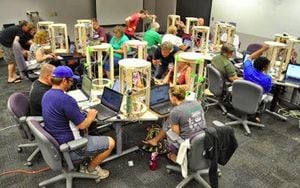J.M.Pearce (talk | contribs) (Created page with "{{MOST}} {{Pearce-pubs}} {{MOST-RepRap}} ==Source== * J.L. Irwin, D.E. Oppliger, J.M. Pearce, G. Anzalone, Evaluation of RepRap 3D Printer Workshops in K-12 STEM. ''122nd ASE...") |
J.M.Pearce (talk | contribs) mNo edit summary |
||
| Line 7: | Line 7: | ||
==Abstract== | ==Abstract== | ||
As facilitators of 3D printer workshops, the authors developed a survey to gage how the | [[image:Deltateacherworkshop.jpg|right|300px]]As facilitators of 3D printer workshops, the authors developed a survey to gage how the | ||
printers are actually being used and whether they support the Next Generation Science | printers are actually being used and whether they support the {{W|Next Generation Science | ||
Standards (NGSS) requirements, especially in regard to engineering design. The survey | Standards}} (NGSS) requirements, especially in regard to engineering design. The survey | ||
response rate was 52% of 68 total participants with the majority conveying that 3D | response rate was 52% of 68 total participants with the majority conveying that 3D | ||
printers do facilitate student understanding of the engineering design process and that the | printers do facilitate student understanding of the engineering design process and that the | ||
| Line 22: | Line 22: | ||
[[3-D printing]]; | [[3-D printing]]; | ||
[[Open-source hardware]]; | [[Open-source hardware]]; | ||
[[STEM | [[STEM]]; | ||
==See also== | ==See also== | ||
Revision as of 01:20, 28 June 2015
Source
- J.L. Irwin, D.E. Oppliger, J.M. Pearce, G. Anzalone, Evaluation of RepRap 3D Printer Workshops in K-12 STEM. 122nd ASEE Annual Conf. and Exposition, paper ID#12036, 2015.
Abstract

As facilitators of 3D printer workshops, the authors developed a survey to gage how the
printers are actually being used and whether they support the [[Wikipedia:Next Generation Science Standards|W]] (NGSS) requirements, especially in regard to engineering design. The survey response rate was 52% of 68 total participants with the majority conveying that 3D printers do facilitate student understanding of the engineering design process and that the workshops empowered them and their students to tackle projects previously perceived as beyond their skill level. Insufficient preparation for troubleshooting hardware and software issues was listed as the greatest barrier to fully realizing the technology’s potential in the classroom. Also highlighted was a lack of resources for development of meaningful lesson plans using this nascent technology.
Keywords
3-D printing; Open-source hardware; STEM;
See also
- Open-source 3-D printing Technologies for Education: Bringing Additive Manufacturing to the Classroom
- Delta Build Overview:MOST
- Category:MOST RepRap build
- Delta Build Workshop
- The RepRap 3-D Printer Revolution in STEM Education
- Implementing Self-Replicating Rapid Prototypers (RepRaps) into a Mechanical/Manufacturing Program





